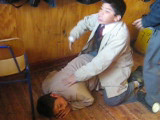 |
| Some guys doing intimidation in Instituto Regional Federico Errázuriz, Santa Cruz, Chile (Photo credit: Wikipedia) |
Bullying remains the hottest of hot button issues in special education law. In the first installment, I explained the early cases laying the conceptual groundwork for the proposition that failure to react to bullying can constitute a denial of FAPE under IDEA. In a later installment, I discussed the seminal decision of TK & SK ex rel LK v. New York City Dept of Educ 779 F.Supp.2d 289, 56 IDELR 228 (E.D.N.Y. 4/25/2011). This case is important not just because it analyzes special education law principles involving bullying, but also because it provides a thorough review of the social science literature on bullying. You should read this case and you can do so here.
Today I provide more of the court's opinion. You really should read the whole thing. These are not my words:
1. What Constitutes Bullying
Bullying is not a new phenomenon; literature is blotted with bullies, and many people have had personal experience with a schoolyard antagonist. Dan Olweus, Bully at School: What We Know and What We Can Do 1 (1993). The bully-victim relationship is characterized by a real or perceived imbalance of power and encompasses a variety of negative acts that are carried out repeatedly over time. Id. at 9; Nels Ericson, U.S. Dep't of Justice Office of Juvenile Justice and Delinquency Prevention Fact Sheet,Addressing the Problem of Juvenile Bullying 1 (2001), available at http://www.ncjrs.gov/pdffiles1/ ojjdp/fs200127.pdf. Negative actions can broadly be described as inflicting or attempting to inflict discomfort upon another. Olweus, supra, at 9. Bullying takes three forms: physical (e.g. hitting); verbal (e.g. taunting); and psychological (e.g. engaging in social exclusion). Ericson, supra, at 1. Indirect, psychological bullying, in the form of exclusion and isolation is often less visible, but not less corrosive. Olweus, supra, at 10. "The consensus among physicians and social scientists, educators and youth development organizations, civil rights advocates and law enforcement is that bullying is neither inevitable nor normal. . . ." Julie Sacks and Robert S. Salem, Victims Without Legal Remedies: Why Kids Need Schools to Develop Comprehensive Anti-Bullying Policies, 72 Alb. L. Rev. 147, 147-48 (2009). Despite this consensus, bullying continues to occur at an alarming rate. A study by a group of psychologists provides an illustration. While observing groups of kindergarten and first grade students, researches noted an incident of bullying on the playground every three to six minutes. James Snyder et. al., Observed Peer Victimization During Early Elementary School: Continuity, Growth, and Relation to Risk for Child Antisocial Depressive Behavior, 74 Child Dev. 1881, 1885 (2003).
"(T)he highest prevalence of bullying is among elementary-school aged children." Gwen M. Glew et. al.,Bullying Psychological Adjustment, and Academic Performance in Elementary School, 159 Archives of Pediatric and Adolescent Med. 1026, 1026 (2005). Younger students of both sexes are the most likely to be singled out as victims. J.F. Devoe and S. Kaffenberger, U.S. Dep't of Educ., Student Reports on Bullying: Results from 2001 School Crime Supplement to the National Crime Victimization Survey 14 (2005), available at http://nces.ed.gov/pubs2005/2005310.pdf. Children who struggle academically are more likely to be victims or be both victim and aggressor. Glew, supra, at 1030. Bullying can be carried out by an individual or a group. Olweus, supra, at 9. The victim of school bullying is most often a single person. Id.
Initially, victimization is situational; "only over time does the field of children who are consistently victimized become narrowed on the basis of ongoing experience." Snyder, supra, at 1881; Macklem,supra, at 66 (finding that once a child is labeled a victim, his status within the peer group drops). This leads to a subset of children being caught up in a "vicious cycle in which victimization and maladjustment feed off one another." Snyder, supra, at 1881. In particular, girls who are unable to develop supportive peer relationships are at an increased risk for persistent ostracism and rejection. Id.at 1895.
"Youth who are victimized are likely marginalized from the mainstream peer group, lacking access to prosocial peers who provide role models of appropriate social skills, and also protection against bullying." Nansel, supra, at 735. The most common place for victimization in elementary school is the playground, followed by the classroom and gym class. Glew, supra, at 1029.












Good Post
ReplyDeleteThanks
ReplyDeleteJG